 |
|

|
 |
TABLE of CONTENTS
|
Hwy 169 opens one month early |
By Rich Kemp
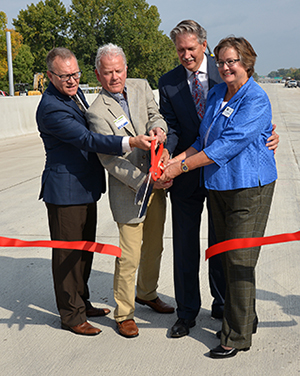
Scott McBride, Metro District engineer; Minnetonka City Council Member Brad Wiersum; Edina Mayor Jim Hovland; and Hopkins Mayor Molly Cummings took part in the ribbon-cutting ceremony for the Hwy 169 Nine Mile Creek project Sept. 22. Photo by Rich Kemp |
Scott McBride, Metro District engineer, joined local leaders Sept. 22 to celebrate the completion of the Nine Mile Creek Causeway and improvements to Hwy 169 between Hwy 62 and Hwy 55.
Work on the project began in January and was complete one month early. Hwy 169 opened to traffic Sept. 26.
“We have never had a project of this magnitude where we closed a roadway that serves 90,000 people a day in the metropolitan area,” said McBride. “What that allowed us to do though was take a project that would have taken two - three years to construct and do it in one construction season.”
McBride joined Edina Mayor Jim Hovland, Hopkins Mayor Molly Cummings and Minnetonka City Council Member Brad Wiersum for the ceremonial ribbon-cutting.
“We appreciate the support and the patience of the motorists and the residents of the cities of Minnetonka, Edina, Hopkins and St. Louis Park,” said McBride.
The $64 million project replaced the Hwy 169 bridge over Nine Mile Creek with a causeway, which is a raised road across a low or wet ground. In addition to replacing the bridge, Hwy 169 and nearby ramps were resurfaced, some noise walls were replaced and safety and accessibility improvements were made.
“We never really ran into any major issues we couldn’t overcome,” said Curt Kallio, project engineer. “Ames Construction was able to work double shifts throughout the project, and having the road closed to traffic was a huge factor.”
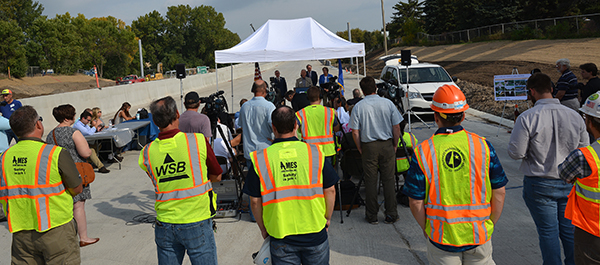
Construction crews, community members and media attended the news conference to announce that Hwy 169 Nine Mile Creek project was going to open one month early. Photo by Rich Kemp |
|
 |
|

|
 |
TABLE of CONTENTS
 |
Community meetings provide updates on additional passenger train service to Chicago |
By Mary McFarland Brooks
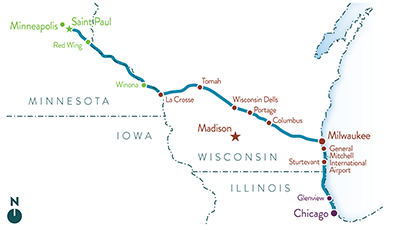
This map shows the proposed route and stops for the Twin Cities – Milwaukee – Chicago Intercity Passenger Rail service. |
Two community engagement meetings held in September for the proposed Twin Cities – Milwaukee – Chicago Intercity Passenger Rail Service project received a positive response from the participants, according to Praveena Pidaparthi, Passenger Rail Office and MnDOT’s TCMC project manager.
The open houses, held in La Crosse, Wis., and at the Union Depot in St. Paul, provided information and updates on the Phase I study being conducted for the proposed additional service, and invited comments and feedback from the public. Information provided included the purpose and need for the proposed project, the alternatives analysis process and recommended alternatives, proposed infrastructure improvements, schedule and next steps for the project.
Staff from MnDOT, Ramsey County Regional Railroad Authority, La Crosse Area Planning Committee, Amtrak and the consultant team were available to discuss the project with the participants. The following advocacy groups were also at the events to answer questions:
- All Aboard Wisconsin
- All Aboard Minnesota
- Minnesota High-Speed Rail Commission
- The Environmental Law and Policy Center
Approximately 65 participants were at the La Crosse community engagement event and 90 attended the Union Depot event.
The comments submitted during the community engagement meetings included several common themes, including general support for the second train, requests to include Wi-Fi and dining cars, an earlier arrival time in Chicago for those traveling from St. Paul, and an accelerated project schedule to implement the second train prior to 2022.
All materials from the meetings, including the video of the Union Depot presentation, are available on the project website. |
 |
|

|
 |
TABLE of CONTENTS
 |
More than 100 snowplow operators receive training during first SPOT session |
|
By Rich Kemp
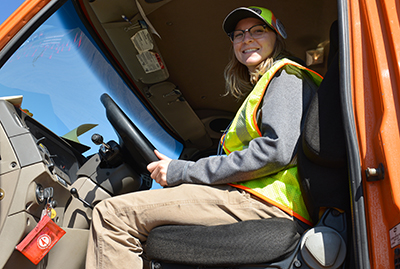
Ruby Hopp, District 1 maintenance, participated in the SPOT training at Camp Ripley Sept. 18-29. Photo by Rich Kemp |
MnDOT’s snowplow operator training program, known as SPOT, trained more than 100 snowplow operators Sept. 18-29 at Camp Ripley near Little Falls. Snowplow operators from MnDOT and the city of Minneapolis learned how to safely and effectively plow snow.
The two-week session teaches a variety of safety measures, plowing techniques and best practices. The session provides trainees with updates on new equipment and policies and procedures related to winter highway maintenance operations.
As part of SPOT, maintenance supervisors and other staff provide classroom and hands-on training and share their experience and insights with the trainees.
For Ruby Hopp, Pike Lake Truck Station in Duluth, who started in May as a 20-year-old, the veteran drivers at her shop and the SPOT trainers are a big help. While in high school she thought about being a firefighter and driving a fire truck. Now she is driving a 50,000 pound single-axle snowplow.
“At first it was really intimidating coming into a shop with only one other female, being skinny and not very muscular,” said Hopp. “However, everyone was always very helpful, offering help, giving tips to make the job a little bit easier.”
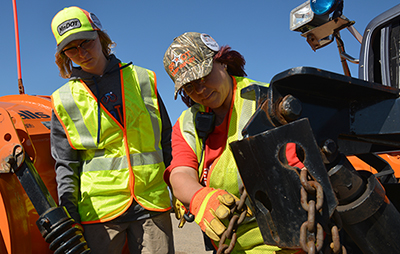
Ruby Hopp (left) gets advice from SPOT instructor Heidi Olsen during snowplow operator training at Camp Ripley Sept. 21. Olsen is also a mentor for Hopp at the Pike Lake Truck Station in Duluth. Photo by Rich Kemp |
The students start in the classroom and then get hands-on experience that includes safety procedures, plowing techniques, updates on new technology and best practices.
“The biggest challenge so far was getting to know the truck and how it operates,” said Hopp. “I was never one to get under the hood of my car and get to know the parts… that has been the hardest part, but also something fun to learn.”
MnDOT has trained more than 1,700 snowplow operators since the training began in 2004.
“Our snowplow operator training program offers unique and specialized training that makes our snowfighters ready for any kind of Minnesota winter,” said Steve Lund, state maintenance engineer.
MnDOT will conduct a second SPOT session Oct. 16-27, where an additional 105 snowplow operators will be trained.
“The truck is a big machine, but the key is knowing how to operate the plow right,” said Hopp. “It is nice to be up and have a higher view of the road. There is an adrenaline rush when you get in that seat and are in control of all these levers and buttons.” |
 |
|

|
 |
TABLE of CONTENTS
 |
MnDOT to pilot autonomous shuttle bus project |
By Sue Roe
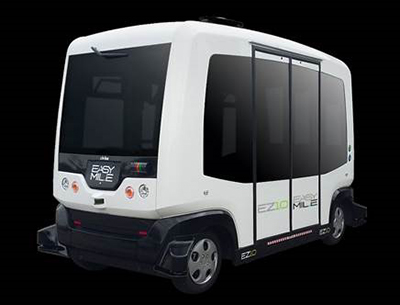
MnDOT will test the EZ10 autonomous shuttle bus at MnROAD starting in November. The low-speed electric shuttle operates using pre-programmed GPS mapping. Photo courtesy of EasyMile |
The Office of Traffic, Safety and Technology will begin testing the use of an autonomous shuttle bus in a cold weather climate in November. The pilot project, announced in June, is moving into the second phase, which includes a controlled demonstration at MnROAD.
Jay Hietpas, state traffic engineer and project director, said EasyMile, a France-based company specializing in driverless technology, was hired to lead MnDOT through the testing phase.
“EasyMile’s expertise will help us learn how these vehicles operate in a winter weather environment so we can advance this technology and position MnDOT and Minnesota as a leader,” he said. “We know this technology is coming fast, so MnDOT wants to be prepared with the technology and regulatory standards.”
This will be the company’s first cold weather test site in the U.S. It previously has tested its EZ10 electric shuttle bus for more than 60,000 miles in 14 countries. The low-speed shuttle operated in various environments and traffic conditions, all without a single crash.
The shuttle can transport between six and 12 people. It has no steering wheel or pedals and operates using pre-programmed GPS mapping. It operates as a Level 4 automation, which means the automated system can conduct the driving task and monitor the driving environment without needing a human to take control.
“Level 4 also means the system can operate only in controlled environments and under certain conditions,” said Michael Kronzer, Intelligent Transportation Systems project manager.
Testing will include how the shuttle operates in snow and ice conditions, at low temperatures and on roads where salt is used.
“There’s not been much research done in the northern climates,” Hietpas said. “We will identify the challenges of operating autonomous vehicles in winter and test potential solutions at MnROAD.”
He said 3M will partner with MnDOT so the company can research various connected vehicle components that interface with infrastructure.
The testing will continue through February 2018, when the shuttle is expected to be showcased during the week of the Super Bowl in Minneapolis.
Kronzer said there are many benefits to using an autonomous shuttle bus, including safer roads, improved mobility services, reduced congestion, reduced energy consumption and a cleaner environment.
“The safety factor alone is a big benefit,” said Kronzer. “Autonomous technology could help reduce crashes and save lives.”
MnDOT is also involved in legislative and regulatory issues dealing with operating autonomous vehicles in the state. Ray Starr, assistant state traffic engineer, said MnDOT and other affected state agencies are discussing possible legislative proposals to help enable the safe testing of advanced automated vehicles.
MnDOT has conducted other research on autonomous and connected technology. The agency already has driver assist systems in its snowplows. It is currently researching other smart in-vehicle technologies, such as lane departure and advance curve speed warning systems, roadway mapping for fog line detection and intersection collision avoidance systems. Read more about the research at www.mndot.gov/autonomous/research.html.
For more information on the autonomous bus shuttle project check out the website. |
 |
|

|
 |
TABLE of CONTENTS
 |
Employees can make changes to health benefits during open enrollment |
|
By Dana Hernandez
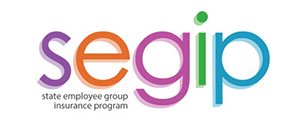
Open enrollment for health benefits is open Oct. 26 to Nov. 8. |
Employees can make changes to their benefits during open enrollment from Thursday, Oct. 26, to Wednesday, Nov. 8. The State Employee Group Insurance Program newsletter will be sent to email and home addresses, providing further information. Enrollment can be completed at the State of Minnesota Self Service site.
Employees can change their medical and dental insurance carriers and add/drop dependent or family coverage. Dependent verification is required for newly added dependents.
Medical premiums will increase by 2.85 percent. Single premiums will be $31.54 per month; family premiums will be $215.16 per month. Medical coverage may be waived with proof of other insurance.
Dental premiums will increase by 18.10 percent or 18.21 percent. Single coverage remains at $13.50 per month and family coverage will be $52.48 per month. Dental coverage may be waived during open enrollment.
Employees also may enroll or increase coverage for short-term disability, long-term disability, child life insurance, employee and spouse life insurance, flexible spending accounts and the Manager’s Income Protection Plan.
Short-term rates will increase by 11.29 percent. Long-term rates and life insurance rates will remain the same.
Employees currently participating in the flexible spending accounts and pre-tax plans for medical, dental, dependent care and transit must re-enroll for 2018. Up to $500 of unused 2017 MDEA dollars may carry over into 2018.
A new pharmacy benefit manager, CVS Caremark, for SEGIP members starting next year. Highlights of the new prescription drug benefit plan can be found on Minnesota Management and Budget’s SEGIP News and Updates site.
During open enrollment, employees also can sign up for a StayWell Health Assessment, which includes completing a personal health assessment and accepting a health coach call to receive $5 reduction in office visit copayments in 2017. Register for an account with StayWell now at https://SEGIP.StayWell.com and complete the personal health assessment during the open enrollment period.
The schedule for open enrollment meetings can be found on MMB’s 2017 SEGIP Benefit Information webpage.
Central Office employees may contact Deborah Schifsky at 651-366-3405; Pam Horwath at 651-366-3376; or Connie Eystad at 651-366-3398. District employees may contact their district human resources staff or SEGIP at 651-355-0100 for more information. |
 |
|

|
 |
TABLE of CONTENTS
 |
Sell your stuff through online Employee Bulletin Board |
Employees can sell items internally by submitting an item to the Employee Bulletin Board on iHUB. They can also check out the bulletin board if they are looking to purchase items.
The EBB can also be used for information employees would like to share agency-wide.
New submissions are posted weekly and the information is kept current, making the site an optimal choice whether someone is looking, selling or notifying.
An EEB administrator
will review the request and send you an email if/when it gets posted. New submissions are typically posted once a week and will remain up for a standard one-month period.
Categories within the Employee Bulletin Board include:
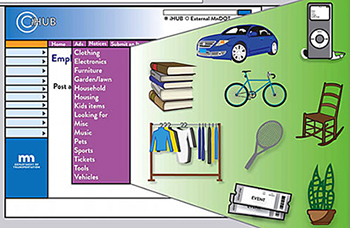
The Employee Bulletin Board offers several categories for employees to buy or sell items. |
Advertisements
- Music/Instruments
- Electronics
- Furniture
- Garden/lawn
- Household
- Housing
- Kids Items
- Clothing
- Pets
- Sports
- Tickets
- Tools
- Vehicles
Notices
- Benefits/Fundraisers for current or retired MnDOT individuals
- Funerals
- Retirements
- Births
Make sure to check the EBB submission guidelines and MnDOT’s appropriate use policy before sending in items. |
 |
|

|
|

|
|
| |
|



